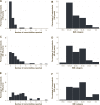Age, physical inactivity, obesity, health conditions, and health-related quality of life among patients receiving conservative management for musculoskeletal disorders
- PMID: 25031532
- PMCID: PMC4099103
- DOI: 10.2147/CIA.S61732
Age, physical inactivity, obesity, health conditions, and health-related quality of life among patients receiving conservative management for musculoskeletal disorders
Abstract
Background: Musculoskeletal conditions and insufficient physical activity have substantial personal and economic costs among contemporary aging societies. This study examined the age distribution, comorbid health conditions, body mass index (BMI), self-reported physical activity levels, and health-related quality of life of patients accessing ambulatory hospital clinics for musculoskeletal disorders. The study also investigated whether comorbidity, BMI, and self-reported physical activity were associated with patients' health-related quality of life after adjusting for age as a potential confounder.
Methods: A cross-sectional survey was undertaken in three ambulatory hospital clinics for musculoskeletal disorders. Participants (n=224) reported their reason for referral, age, comorbid health conditions, BMI, physical activity levels (Active Australia Survey), and health-related quality of life (EQ-5D). Descriptive statistics and linear modeling were used to examine the associations between age, comorbidity, BMI, intensity and duration of physical activity, and health-related quality of life.
Results: The majority of patients (n=115, 51.3%) reported two or more comorbidities. In addition to other musculoskeletal conditions, common comorbidities included depression (n=41, 18.3%), hypertension (n=40, 17.9%), and diabetes (n=39, 17.4%). Approximately one-half of participants (n=110, 49.1%) self-reported insufficient physical activity to meet minimum recommended guidelines and 150 (67.0%) were overweight (n=56, 23.2%), obese (n=64, 28.6%), severely obese (n=16, 7.1%), or very severely obese (n=14, 6.3%), with a higher proportion of older patients affected. A generalized linear model indicated that, after adjusting for age, self-reported physical activity was positively associated (z=4.22, P<0.001), and comorbidities were negatively associated (z=-2.67, P<0.01) with patients' health-related quality of life.
Conclusion: Older patients were more frequently affected by undesirable clinical attributes of comorbidity, obesity, and physical inactivity. However, findings from this investigation are compelling for the care of patients of all ages. Potential integration of physical activity behavior change or other effective lifestyle interventions into models of care for patients with musculoskeletal disorders is worthy of further investigation.
Keywords: aging; comorbidity; orthopedic; overweight; physical activity; sedentary.
Figures




References
-
- Côté P, van der Velde G, Cassidy JD, et al. Bone and Joint Decade 2000–2010 Task Force on Neck Pain and Its Associated Disorders The burden and determinants of neck pain in workers: results of the Bone and Joint Decade 2000–2010 Task Force on Neck Pain and Its Associated Disorders. Spine (Phila Pa 1976) 2008;33(4 Suppl):S60–S74. - PubMed
-
- Parker L, Nazarian LN, Carrino JA, et al. Musculoskeletal imaging: medicare use, costs, and potential for cost substitution. J Am Coll Radiol. 2008;5(3):182–188. - PubMed
-
- Praemer A, Furner S, Rice DP, American Academy of Orthopaedic Surgeons . Musculoskeletal Conditions in the United States. Park Ridge, IL: American Academy of Orthopaedic Surgeons; 1992.
-
- Stewart WF, Ricci JA, Chee E, Morganstein D, Lipton R. Lost productive time and cost due to common pain conditions in the US workforce. JAMA. 2003;290(18):2443–2454. - PubMed
-
- van Tulder MW, Koes BW, Bouter LM. A cost-of-illness study of back pain in The Netherlands. Pain. 1995;62(2):233–240. - PubMed
MeSH terms
LinkOut - more resources
Full Text Sources
Other Literature Sources
Medical

